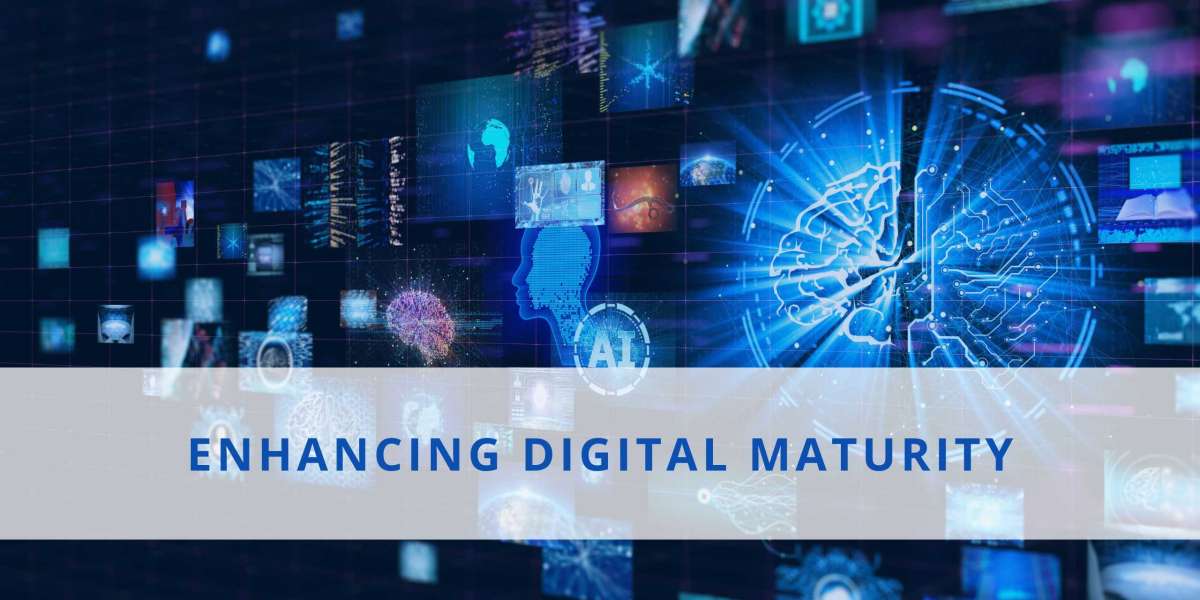Digital Maturity refers to how effectively an organization uses digital technologies to improve performance, customer experiences, and operational efficiency. In 2025, it encompasses AI-driven decision-making, automation, cybersecurity resilience, omnichannel strategies, and data intelligence. Companies with high digital maturity can respond faster to disruptions, innovate at scale, and lead their industries.
Organizations pass through several digital maturity stages:
- Initiation: Basic digital tools, limited automation
- Adoption: Standard digital practices, departmental tech use
- Integration: Cross-functional digital alignment
- Optimization: Data and AI-driven decision-making
- Innovation: Fully agile, digital-first, predictive and adaptive
Step 1: Assess Current Digital Maturity Level
Before initiating change, enterprises need to conduct a digital maturity assessment. This evaluation helps identify strengths, gaps, and growth opportunities.
Key assessment metrics:
- Technology adoption (cloud, AI, automation)
- Digital skills and employee readiness
- Customer experience metrics
- Data integration and analytics usage
- Cybersecurity protocols
- Business agility and innovation capabilities
Use digital maturity frameworks such as MIT’s Digital Maturity Model or Deloitte’s Digital DNA to benchmark your organization.
Step 2: Set a Clear Digital Vision
Every successful transformation starts with a strategic vision. In 2025, this vision should reflect how digital capabilities align with long-term business objectives. Whether it's expanding to new markets, enhancing customer loyalty, or automating workflows, clarity drives impact.
How to set your digital vision:
- Involve leadership and stakeholders
- Align goals with industry trends
- Define KPIs linked to digital success
- Prioritize customer-centric outcomes
- Document and communicate the vision
Step 3: Build a Digitally-Ready Workforce
Digital Maturity is not just about tools—it's about people. Employees must be upskilled and empowered to work in agile, tech-driven environments.
2025 digital workforce strategy:
- Provide training in AI, data analytics, cybersecurity
- Promote a culture of innovation and experimentation
- Redesign roles to align with digital workflows
- Encourage cross-functional collaboration
- Integrate tech adoption into performance goals
Step 4: Leverage the Right Technologies
Choosing the right technology stack is crucial for digital evolution. In 2025, the tech ecosystem has expanded, offering companies more options than ever.
Recommended technologies for digital maturity:
- Cloud computing for scalability and remote access
- Artificial Intelligence ML for predictive insights
- Robotic Process Automation (RPA) for operational efficiency
- Customer Data Platforms (CDPs) for unified customer profiles
- Cybersecurity solutions to protect data integrity
- IoT Edge Computing for real-time operations
Always align tech adoption with your business model and customer needs.
Step 5: Redesign Customer Journeys
A key aspect of Digital Maturity is delivering seamless, personalized customer experiences. Businesses should map and optimize every digital touchpoint.
Customer journey actions:
- Map out digital channels (web, mobile, social, in-app)
- Use analytics to understand behavior and friction points
- Apply AI for hyper-personalization
- Integrate CRM, CDP, and ERP for unified experience
- Automate support via chatbots and self-service platforms
By 2025, customers expect proactive service and real-time engagement—mature businesses deliver both.
Step 6: Embed Data into Decision-Making
Enterprises that mature digitally become data-first organizations. They embed data into every decision, from product launches to marketing strategy.
Steps to become data-driven:
- Centralize data into cloud-based platforms
- Adopt advanced analytics and visualization tools
- Train teams in data literacy
- Use predictive modeling for strategic planning
- Continuously monitor KPIs and adapt based on real-time metrics
Digital Maturity means transitioning from gut-feeling decisions to evidence-based actions.
Step 7: Create Agile, Scalable Operations
Agility is at the core of Digital Maturity. In 2025, enterprises need operating models that are modular, fast, and resilient to market shocks.
Build operational agility by:
- Adopting DevOps and agile frameworks
- Streamlining supply chains with AI and IoT
- Outsourcing non-core processes to focus on innovation
- Automating routine tasks to reduce error and cost
- Using APIs to enable system interoperability
Scalable operations reduce time-to-market and enhance customer satisfaction.
Step 8: Monitor, Optimize, and Evolve
Digital Maturity is not a one-time project—it’s a continuous journey. Companies must constantly measure performance, optimize systems, and adapt to new technologies.
Ongoing actions:
- Conduct regular digital audits
- Reassess KPIs based on evolving trends
- Review customer feedback and satisfaction scores
- Monitor cybersecurity threats and strengthen protection
- Stay updated on tech innovation and competitors
With a feedback loop in place, businesses can continuously elevate their digital capabilities.
Step 9: Strengthen Cybersecurity Frameworks
As businesses digitize more assets, cybersecurity becomes a foundational part of digital maturity. In 2025, with increasing regulatory scrutiny and cyber threats, companies must protect digital infrastructure at all levels.
Cybersecurity essentials for digital maturity:
- Zero-trust architecture
- Endpoint protection and network segmentation
- Threat intelligence systems
- Compliance with data privacy regulations
- Cyber training for all employees
Cybersecurity resilience builds trust, which is critical in a digital-first economy.
Step 10: Foster a Culture of Digital Innovation
Digital Maturity thrives in an environment where innovation is not occasional but continuous. A culture that encourages curiosity, risk-taking, and experimentation will always stay ahead.
Cultivating innovation in 2025:
- Reward creative problem-solving
- Set up digital innovation labs
- Collaborate with startups and tech partners
- Use internal hackathons to test ideas
- Give employees time for personal tech projects
Cultural transformation supports long-term digital maturity and enterprise reinvention.
Read Full Article: https://businessinfopro.com/enhancing-digital-maturity-with-a-step-by-step-guide-in-2025/
About Us:
BusinessInfoPro is a dynamic B2B insights hub offering timely, expert‑driven content tailored for professionals in finance, HR, IT, marketing, sales and more. Through in‑depth articles, whitepapers and downloadable guides, we illuminate critical industry trends like AI’s economic impact, data‑driven decision‑making and strategic marketing in uncertain economies. Our resources empower leaders to optimize efficiency, strengthen customer engagement and embrace sustainable innovation. With fresh publications covering cutting‑edge topics sustainability, workforce transformation, real‑time architecture and practical tools from top platforms and thought‑leaders, Business Info Pro equips businesses to adapt, compete and thrive in a fast‑changing global landscape.











